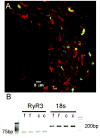Inhibition of cerebral vasoconstriction by dantrolene and nimodipine
- PMID: 18923817
- PMCID: PMC2744156
- DOI: 10.1007/s12028-008-9153-0
Inhibition of cerebral vasoconstriction by dantrolene and nimodipine
Abstract
Introduction: Cerebral vasoconstriction is associated with increased cytosolic Ca(2+) concentration in vascular smooth muscle, presumably due to Ca(2+) influx and Ca(2+) release from intracellular stores. We tested the hypothesis that dantrolene (a blocker of Ca(2+)-induced Ca(2+) release from the ryanodine receptor channel on the sarco-endoplasmic reticulum) would potentiate the action of nimodipine (a voltage-dependent L-type Ca(2+) channel blocker, considered standard therapy for SAH) in inhibiting the vasoconstriction of isolated cerebral arteries.
Method: Sprague-Dawley rat basilar and femoral arteries were analyzed for ryanodine receptor expression by immunofluorescence and PCR. Vasoconstriction of basilar artery ex vivo was measured in a wire myograph while exposed to serotonin (5-HT) or endothelin-1 (ET-1) in the presence or absence of dantrolene (10-100 muM) and/or nimodipine (30 nM). Femoral artery was examined for comparison.
Results: Basilar and femoral arteries express only the ryanodine receptor 3 (RyR3) isoform. In both basilar and femoral arteries, dantrolene significantly inhibited the constriction to 5-HT, whereas it poorly affected the constriction to ET-1. The inhibitory effect of dantrolene on 5-HT was substantially increased by nimodipine, inducing a 10-fold increase in the 50% effective concentration of 5-HT and a 46% reduction in maximum basilar constriction. In femoral artery, dantrolene modestly affected constriction to phenylephrine and there was no interaction with nimodipine.
Conclusion: Dantrolene has synergistic effects with nimodipine against 5-HT-induced vasoconstriction in isolated cerebral arteries. Dantrolene-nimodipine interaction will require testing in a pathophysiological model but might provide treatment for reducing SAH-related vasospasm or other 5-HT-related vasospastic syndromes, such as Call-Fleming syndrome.
Figures






References
-
- Krause T, Gerbershagen MU, Fiege M, Weisshorn R, Wappler F. Dantrolene--a review of its pharmacology, therapeutic use and new developments. Anaesthesia. 2004;59(4):364–73. - PubMed
-
- Endo M. Calcium ion as a second messenger with special reference to excitation-contraction coupling. J Pharmacol Sci. 2006;100(5):519–24. - PubMed
-
- Zhao F, Li P, Chen SR, Louis CF, Fruen BR. Dantrolene inhibition of ryanodine receptor Ca2+ release channels. Molecular mechanism and isoform selectivity. The Journal of biological chemistry. 2001;276(17):13810–6. - PubMed
-
- Dorsch NW. Cerebral arterial spasm--a clinical review. Br J Neurosurg. 1995;9(3):403–12. - PubMed
-
- Tani E, Matsumoto T. Continuous elevation of intracellular Ca2+ is essential for the development of cerebral vasospasm. Curr Vasc Pharmacol. 2004;2(1):13–21. - PubMed
Publication types
MeSH terms
Substances
Grants and funding
LinkOut - more resources
Full Text Sources
Medical
Miscellaneous

